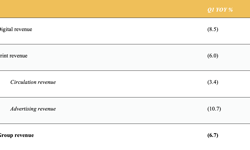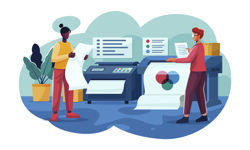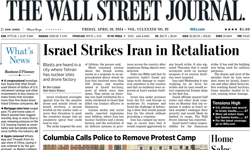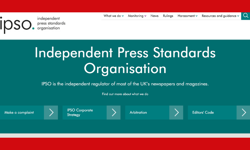Conference chair, Informa’s Caroline Frost started by acknowledging that we’re living through a period of “exponential” change and the challenge was how to “survive and thrive”. Ex Emap CEO David Gilbertson described a “paradigm shift, when the experience and expertise of the outgoing generation does not equip the next for success.”
And, continued Gilbertson, traditional big media was under siege, ill-suited as it was to the rules of the modern game. Big publishing companies, whose financial might was built on economies of scale from their consolidated print and distribution are finding that those cost efficiencies are meaningless in the online environment where manufacturing and distribution costs have all but disappeared. There are disruptors all around, and, annoyingly, our future competitors are unlikely to look anything like our current or past ones, thereby making them rather hard to spot.
Many bigger publishers, said Dominic Jacquesson, are also guilty of failing to manage their product portfolios efficiently, by not investing in the new products, firstly on the web and more recently in the mobile space, that will eventually need to take the place of their established brands in declining markets (ie print). Where are their stars and cash cows of tomorrow? B2C companies in particular, said Dominic, have not managed their cash and are in terminal decline. If he were an investor, he would be more likely to go with a start-up.
Part of the problem for established publishers, said Incisive’s Ken Cooke, was that they were too wedded to their brands and he questioned the real value of brand equity. How much brand equity did Google need in 1998? Ken was particularly impressed with RBI’s XpertHR which had built itself up into a leading HR site by eschewing any link with an existing print brand.
Gilbertson’s advice to publishers was to “think big, but act small”. Successful digital companies are fast, nimble, dynamic, focused and accountable. Energy and drive are key parts of their DNA.
And … who should be the leaders of tomorrow’s publishing companies? Marketers. Editorial and sales are not best placed to lead, said Gilbertson. Drawing a culinary parallel, they might be the chefs and silver service waiters but it is the marketer who is best placed to decide the menu. Marketers, he said, had a “critical role to play in driving the industry forward”.
Dan Brown advocated a decentralised matrix model organisational structure, where small teams would be headed by a product manager, a role that marketers were particularly well placed to fulfil. But, marketers had to step up to the plate. Their focus should not be supplier management or pantone selection, but on “demonstrating to your business how your products meet the real needs of your market”.
Institutional Investor CEO Jane Wilkinson, a former marketing director, has long wanted marketing to strategically drive the business and now thinks that it is. Indeed, across the sector as a whole, she notices marketing departments becoming more strategic as they become increasingly confident in interpreting the data and articulating strategies.
A central theme of the day was the value of content, specifically in spotting the difference between the high value chargeable stuff and the low grade cannon fodder. For Ken Cooke, the key question was: “are you producing what your market values and do you understand where the value in your content lies?” Gilbertson said publishers had a tendency to overstate their own importance and warned against “delusions of grandeur”. The law of commodity markets applies, he said. Is what you have in ready supply? Is it available from low cost or free alternatives? Is it indistinctive? If the answer to any of these is ‘yes’, then you’ll have a hard job charging for it. He drew the key distinction between interesting ‘information’ and essential ‘intelligence’. One was nice to have, but few would bother paying for it and the other was must-have and could be priced accordingly. To command a price, content had to show a return to the subscriber, a return on their money and as importantly, a return on their time. According to Ken Cooke, the monetisable elements of content are those that enable the reader to mitigate risk, save time, increase revenue and reduce costs.
By that criteria, most ‘news’ was not chargeable, but high level exclusive news (step forward the FT) could still command a price.
And, to get into the charging zone, the best place to be was as close as possible to the processes of their customer. Dan Brown said: “the companies who succeed will be those that come closest to incorporating themselves into workflows.” “Our objective should be”, he said, “to build a website that’s the equivalent of a Bloomberg terminal!”
Part of the task is clearly the quality of your content; another is the design of your web interface. “Print is great for engagement, online’s crap (unless you put in place great marketing)”, said Ken Cooke. According to Jane Wilkinson, readers take eight seconds to form an opinion of the value of a printed page, and about one tenth of that for an online page. She urged publishers to spend time in optimising the user experience by not hiding the useful stuff away and making the experience as hassle free as possible. For Dan Brown, presentation and design were fundamental issues. The online world is eroding our concentration skills, he said, with the plethora of in-context links giving us all a touch of ADHD. How do we get readers’ spellbound attention, how do we turn our place into TS Eliot’s “still point in a turning world”? For a start, he suggested having all articles open in a separate window and, secondly, turning current orthodoxy on its head, how about removing all in-context links! Rip up the rule book!
Talking of rule books, the one for mobile is still very much work in progress. Judging by some of the comments at the round table sessions, few claim to have got it right. There is lots of experimentation and strategy is being made on the hoof, in response to new devices, new social media channels and yo-yoing publisher priorities. The result is that inconsistencies and contradictory strategies abound. One publisher frankly admitted that their site currently let people from Google in but blocked people from Facebook, but couldn’t think of a good reason why and worried that the strategy was probably back to front. Inevitably, strategies will start to coalesce, but for now, the important thing is to be out there experimenting and learning.
Mobile is now centre stage. Whereas early mobile strategies assumed back-of-the-cab-on-the-way-to-a-meeting usage, publishers now must assume almost constant usage. The phone is no longer peripheral but a central information source; Andy McLaughlin referred to the “shift from desktop to mobile and the growing dependence on mobile devices. Mobile has become part of people’s lives and workflow and people expect stuff to be on it.” He urged all delegates to review their business plans for the year ahead to make sure that mobile is in it.
HTML5 was changing the dynamics of tablet design and possibly leading to a diminution in the power of Apple. Certainly, the recently launched FT web app had created a real buzz, and I heard one publisher describe how they had immediately performed a strategy u-turn on the back of it. But Dominic cautioned us not to get too carried away, drawing attention to the still enormous marketplace that iTunes represents and the fact that HTML develops very slowly. HTML4 dates back to 1997, so who knows when HTML6 will make an appearance. 2025? So whilst HTML5 gives publishers a welcome extra string to their bow, Dominic expects Apple and iTunes to be at the forefront of app and tablet development for some time to come.
In terms of app design, Dominic was particularly disappointed in the poor quality and lack of imagination in so many publisher apps. The iPad has been widely described as a thing of beauty and the user experience a joyful one. Why then do so many publishers not take this into account and fail to offer anything more exhilarating than drab copies of their print titles. Most of the true innovation was coming from the pure play companies and digital start-ups. With a few notable exceptions (the FT, again, and also Autotrader) traditional publishers were not producing much of note.
The most popular app download? Facebook. What is more, mobile users of Facebook are twice as active as non-mobile, which brings us neatly to social media. As Dominic pointed out, nowadays, it’s not what you say, it’s what people say about you that counts. Virality is the best form of marketing and share buttons on your content is a minimum requirement. Andy McLaughlin said: “As mobile and connectivity gets better and as social media is connected to it, where are you? Is it part of your business plan?” Well, is it?
I have a confession; it’s not yet part of mine, but as a result of my day at SIPA, it has rocketed up my to-do list.










